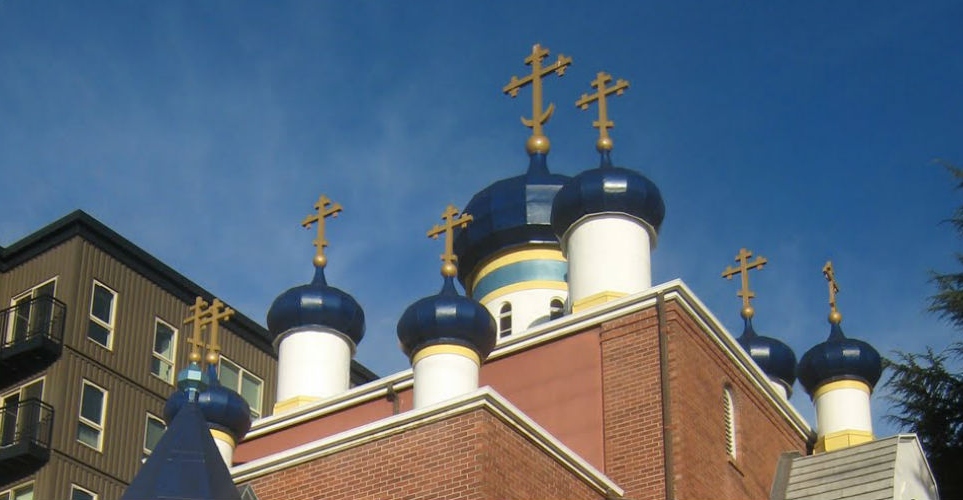With the U.S. purchase of Alaska from Russia in 1867 (for the bargain price of $7.2 million) the Orthodox Church in North America was set adrift. Formerly a Russian mission, it was now part of the turbulent, changing United States.
The first Orthodox church on our West Coast was at Fort Ross, California, founded in 1812. Later, amid dreams of the California Gold Rush, Serbs, Greeks, Syrians, and Russians streamed into nearby San Francisco. A kind of ecumenical orthodoxy resulted, setting a pattern for North American Orthodox churches, including Seattle’s.
Founded as a Greek-Russian parish in 1892, the first St. Spiridon in Seattle was built in 1895. (St. Spiridon was a Cypriot shepherd who became a bishop. His remains are venerated on the Greek island of Corfu.) During the 1890s a large influx of Greek men arrived in Seattle and other American communities. A local Greek club was founded here in 1909. As the old St. Spiridon was losing members, a new St. Demetrius was established in South Lake Union.
A Greek couple donated land at 817 Lakeview Avenue to establish a new house of worship. The original building rested on wooden pillars at a poor angle against Capitol Hill. When the old building began to lean, parishioners became alarmed. In fact, when Bishop Nicholas visited Seattle in 1896 he refused to consecrate the shaky structure. It didn’t help that parishioners argued about the location of the altar, future repair costs, and the site itself.
Contributions were sent to aid immigrants after the abortive 1905 Russian Revolution. St. Spiridon also sent aid to those fleeing the 1917 Revolution, while Father Alexander Vyacheslavov met immigrants at boats from eastern Russian and Chinese ports, found jobs for many, provided others with shelter, and helped qualified students get placed at the University of Washington.
Immediately after the 1917 Russian Revolution membership fell, mostly as a result of protests by older parishioners who opposed the Bolsheviks anti-religious fervor. After White Russian emigres arrived in Seattle, the church rolls increased, and a brief renaissance seemed to be underway. However, many of the immigrants soon left for other American cities and towns.
St. Spiridon Cathedral, once Greek, then Russian, now part of the Orthodox Church of America, found itself caught in 1920s international politics. The building was seized by court order when the communist government in Russia gained control, following a communist procedure with all American Orthodox churches that had not been previously taken over by their membership.
Before the Russian government took full possession of the church angry parishioners removed religious articles in the dark of night and set up temporary services in the basement of a nearby Roman Catholic church.
The struggling little cathedral was turned into a shoe repair shop, and allowed to deteriorate until much of Lakeview Boulevard, including St. Spiridon, was obliterated by Interstate 5 construction. Later, a new independent St. Spiridon rose on nearby Yale Avenue in South Lake Union. The new church’s blue onion-bulb towers remain a landmark in the old Cascade neighborhood.
Following the confusion of road-building and other local changes, many parishioners migrated to St. Demitrios, the impressive Greek Orthodox Church in Montlake on Boyer Avenue East. This modern building was designed by Paul Thiry, a celebrated Seattle architect, and it became familiar for its bazaars and festivals and the hiring of bi-lingual priests.
Discover more from Post Alley
Subscribe to get the latest posts sent to your email.

Interesting!
Great start! Seems like there should be more to the story!
Excellent history lesson, Junius. Thank you. Note to readers: The reference to ‘White Russian emigres‘ in paragraph 6, has nothing to do with skin color. but rather the area of Russia they were from. The story I got from my ancestors was that this area was populated by poor Russian farmers. Dating Catherine the Great’s rule in the mid-late 1700’s German farmers from across the border, who were much more prosperous due to their better farming methods, were invited to move in. They were promised land in return for educating the Russian on how to farm better. Everything went great for about 100 years until Nicholas came to power. His move was to force all the Germans out, and subsequently many came to America.
Catherine the Great of Russia was a German Prussian with a genealogy that is beyond complicated. “White” Russian also is a term used after the 1917 Bolshevik (“RED”) revolution for those who unsuccessfully opposed it. Most of those people were religious. German farmers who were settled in Russia in Catherine’s day (they must have tossed some other folks off those feudal lands) ultimately settled in some numbers in the Palouse Country of Eastern Washington.
I look forward to, and very much enjoy reading, these PA pieces from Junius Rochester. So thank you, Junius, for writing them — I learn a lot from each!
Would love to know your historical notes on the church at 13th and Howell. I loved next door to it for 20 years, and Russian newspapers often collected at the mailbox.